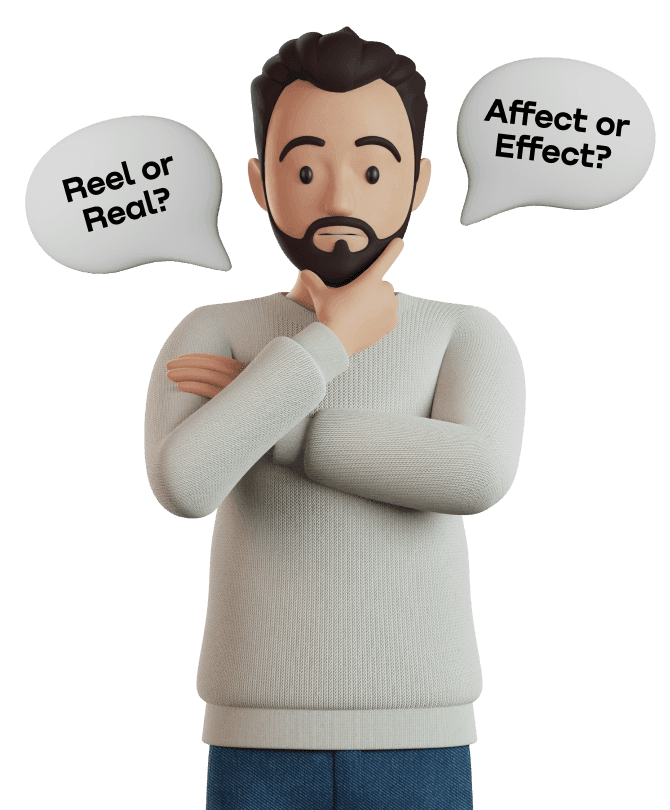Sew vs Sow
What’s the difference between them?

Sew
Meaning:
To join or fasten pieces of fabric or clothing using needle and thread.
Examples:
1. She sewed the torn fabric back together.
2. My grandmother taught me how to sew when I was a child.
3. I sewed some curtains for the living room.
Sow
Meaning:
To plant or scatter seed, especially in a prepared area of soil.
Examples:
1. The farmer had to sow the seeds in the soil carefully.
2. She sowed the wheat in the field in the spring.
3. The gardeners sowed the flower seeds with love and care.
Learn similar and opposite words to spot the difference
Synonyms
Antonyms
Sew
Stitch
seam
tear
Sow
Plant
scatter seed
Reap
Tricks for mastery
Useful tips to understand the difference between confusing words "Sew", "Sow".

1. Sew: The mnemonic or memorable tip to help distinguish between these two words is to think of the phrase 'sew together'. Sew is a verb meaning to stitch or join two pieces of material together.
2. Sow: The mnemonic or memorable tip to help distinguish between these two words is to think of the phrase 'sow the seeds'. Sow is a verb meaning to plant seeds. It is the same spelling in both American and British English.
Practice English with the Promova app and avoid misusing confusing words
Frequently asked questions
When to use the first word?
The word 'sew' can be used as both a noun and a verb. As a verb, it is used to describe the process of using a needle and thread to join materials together, as one might do when making clothes. As a noun, 'sew' can refer to the thread used in the sewing process or to a stitch.
When to use the second word?
The word 'sow' is a verb that describes the process of planting seeds into the soil. It is often used when referring to planting crops or flowers. Additionally, it can be used as a metaphor to describe the process of 'sowing' an idea, attitude, etc. into someone’s mind.
Do the words have the same pronunciation?
No, they do not have the same pronunciation. The word 'sew' is pronounced like 'few' while 'sow' is pronounced like 'toe'.
What are common mistakes associated with words 'sew', 'sow'?
One of the most common mistakes associated with these words is mixing up their usage. People often think that the word 'sew' can only be used to describe the act of planting seeds, and the word 'sow' can only be used to describe the act of sewing. Additionally, people often forget to pronounce the second 'w' in 'sow', leading to incorrect pronunciation.
Fill in the gaps to check yourself
1. I learned to ___ when I was a young girl.
2. My grandmother used to ___ her own vegetables in the garden.
3. In order to ___ a successful crop, the soil must be fertilized.
4. The farmer ___ed the field with wheat in the spring.
5. My mother taught me how to ___ a button on my shirt.
6. The gardener ___ed the flower bed with wildflowers.
1. Sew
Explanation: The verb sew means to use a needle and thread to stitch cloth together, and is the correct word to fill the gap in this sentence.
2. Sow
Explanation: The verb sow means to scatter seed over the ground for plants or crops to grow, and is the correct word to fill the gap in this sentence.
3. Sow
Explanation: The verb sow means to scatter seed over the ground for plants or crops to grow, and is the correct word to fill the gap in this sentence.
4. Sowed
Explanation: The verb sow in the past tense is sowed, and is the correct word to fill the gap in this sentence.
5. Sew
Explanation: The verb sew means to use a needle and thread to stitch cloth together, and is the correct word to fill the gap in this sentence.
6. Sowed
Explanation: The verb sow in the past tense is sowed, and is the correct word to fill the gap in this sentence.
Get a gift by subscribing to our newsletter!
Download the PDF with a list of commonly confused words made as flashcards for comfortable learning.
List of Commonly Confused Words
Finding your way around the English language can be hard, especially since there are so many confusing words and rules. So, a list of the most confusing words in English is an extremely useful tool for improving language accuracy and sharing the ideas clearly.